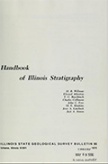Historical:Kress Member
Lithostratigraphy: Ottawa Limestone Megagroup >>Ancell Group >>St. Peter Sandstone >>Kress Member
Chronostratigraphy: Paleozoic Erathem >>Ordovician System >>Champlainian Series >>Blackriveran Stage
Allostratigraphy: Tippecanoe Sequence
Authors
H. B. Willman and T. C. Buschbach
Name Origin
The Kress Member of the St. Peter Sandstone (Buschbach, 1964, p. 51), the basal member, is named for Kress Creek, a stream northwest of West Chicago, Du Page County, near the type section.
Type Section
The type section of the Kress Member is defined near Kress Creek, near which a well (NW NE SE 32, 40N-9E) encountered 64 feet of conglomerate at the base of the St. Peter, the top at a depth of 940 feet. The type section is represented by samples from the well (sample set 1169).
Extent and Thickness
The Kress Member is very irregular in occurrence but has been encountered in many wells. Its maximum thickness is 170 feet in a well in Ogle County, where a thin layer of bentonite occurs near its base.
Description
The Kress in some places is a coarse rubble or conglomerate of chert in a matrix of clay or sand, a residue from the solution of the underlying cherty dolomites and sandstones. At other places the Kress is largely red sandy clay, red and green shale, and argillaceous sandstone that represent reworking of the residual materials by the advancing St. Peter sea. The conglomerate is locally exposed in the Oregon region, Ogle County, and the shale is exposed at Utica, La Salle County.
References
BUSCHBACH, T. C., 1964, Cambrian and Ordovician strata of northeastern Illinois: Illinois State Geological Survey Report of Investigations 218, 90 p.
ISGS Codes
| Stratigraphic Code | Geo Unit Designation |
|---|---|
